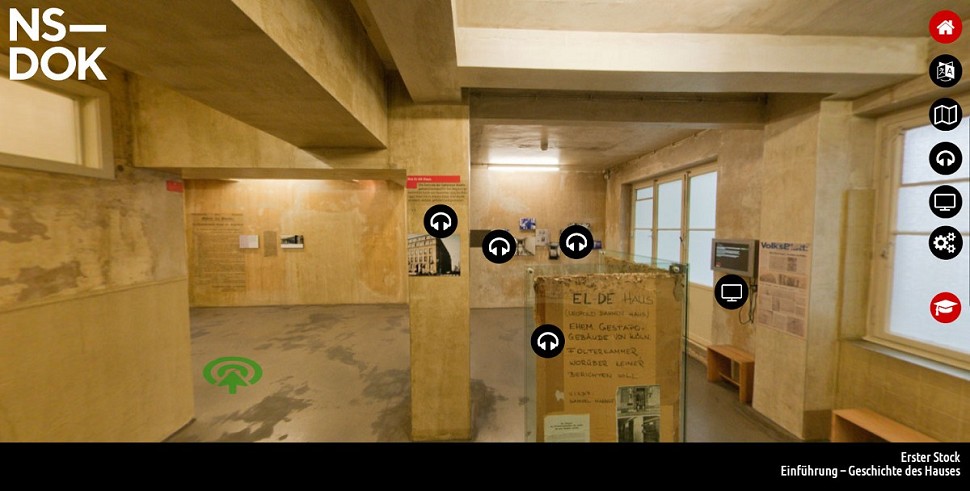Rise and seizure of power
The Cologne NSDAP, founded in 1921, remained an insignificant splinter party for several years. However, Cologne was the centre of the National Socialists in the Rhineland from the very beginning. The political approach by the Cologne National Socialists was characterised by extreme anti-Semitism and a propensity for violence towards political opponents. Even though it was weaker than in other regions, the Cologne NSDAP also achieved a political breakthrough after 1930. As elsewhere, in Cologne in 1933 the seizure of power went without opposition.
Forcible coordination
On 13 March 1933, the National Socialists seized power in Cologne. The terror against opponents was stepped up, all constitutional rights were suspended. In the following weeks and months, all parties, institutions, associations and clubs were dissolved or "forcibly coordinated". This process took place as quickly in Cologne as in the entire Reich.
The National Socialist power machinery
The National Socialist system affected every individual as a whole, not only in the political, but also in the private sphere. The political coverage was achieved by the party and its organisations, orchestrating all areas of life and all age groups, reaching from Reich level down to individual apartment buildings. Those who did not join up out of enthusiasm or did not adapt to the rules and restrictions dictated by the NS regime had to face the terror machinery.
An arranged national community
There were two key components according to the National Socialist concept of the national community. On one hand there was the "Führer", removed from everyday life and beyond criticism, and on the other hand was the "people", the mobilised masses represented the national – and racial – community. This community was to be brought about by Goebbels’ refined propaganda measures. Not being part of the "national community" meant discrimination and persecution.
Youth
Complete control through indoctrination of young people was the declared goal of the NS regime. Boys and girls were to be supervised and controlled by the government both whilst at school and during their leisure time in order to be incorporated into the "Führer state" at an early stage in their lives. The youth organisations of the regime – "Hitler Youth" ("Hitlerjugend" – HJ) and the "League of German Girls" ("Bund Deutscher Mädel" – BDM) – fought the other political, confessional and independent youth organisations, which were eventually forced to disband.
Cologne: Between everyday life and large-scale politics
Religion or "belief in God"?
The de-Christianisation of public and private life was a prerequisite for the National Socialists to implement their claim to power. The NS regime attacked the church and religious communities as political and social institutions as well as traditional religiousness and Christian values. Christian piety was to be replaced by a "popular-Germanic belief in God". Loyalty towards the church was to be replaced by devotion to the "Führer and the Reich".
Racial policy: "Extermination" and "racial improvement"
Racism was the centrepiece of the NS ideology. "Extermination" and "racial improvement" were the two inseparable components of the National Socialist racial policy. On the one hand, there was the fight against the "parasites" and "subhumans", up to their execution and on the other raising "purebred", "Aryan" Germans that was to rule "inferior" peoples as the "master race". Numerous institutions dealing with the implementation of this policy made Cologne a centre of racial policy in the Rhineland.
Racially marginalised and persecuted
"Forgotten victims" are those who were cut off from the "national community" during the NS regime and continued to be marginalised and discriminated against after 1945. They were denied the ethical recognition as victims, official rehabilitation or payment of damages.
Sinti and Roma
Sinti and Roma were labelled »foreign and inferior races« and systemically discriminated against and persecuted. From May 1935 onwards, all Sinti and Roma caravans were forced to relocate to a camp that was used as a sample for other cities, too. In 1940, 1,000 Sinti and Roma were to be the first group of people to be deported from the Rhineland to the ghettos and camps in Poland. From 1943 on, Sinti and Roma were displaced to the Auschwitz-Birkenau Concentration Camp. Only few of them survived.
The Jewish fate
Antisemitism was an essential component of the National Socialist ideology. Existing anti-Jewish and racist ideas were cultivated and turned into a political system to persecute Jews through both legislative measures and terror tactics. The systematic marginalisation of Jewish citizens in both social and economic life began immediately after the seizure of power. In the following years, the anti-Jewish policy focused on looting and driving away Jews. In 1941, deportations to ghettos and concentration camps started. Thousands of Cologne Jews were murdered.
Between adaptation and resistance
Protest against National Socialism was the exception. Approval or adaptation was the norm. There was only a small and fragmented minority that put up active resistance. By 1936/37, the NS regime had put an end to organised resistance. Only during the final phase of World War II, people from very different social strata and varying political groups came together to fight against the NS regime together.
During the war
For the citizens of Cologne, food rationing, blackouts and the Armed Forces draft were the first tangible effects of World War II, which had started with the German attack on Poland on 1 September 1939. As of 1941/42 life in Cologne was increasingly determined by air raids, reducing the town to rubble and causing the death and injury of tens of thousands of people. The optimistic atmosphere of the "Blitzkrieg" phase from 1939/40 was soon followed by abrupt disillusionment, with the "1000 bombers raid" in mid-1942 at the latest.
Forced labour
During the war, thousands of forced labourers, prisoners of war and concentration camp detainees had to work in the Cologne arms industry, often under inhumane working conditions. They were mostly young women and men from Poland and the Soviet Union who were forced to work in Germany. In Cologne alone, there were over 450 forced labour camps or accommodations.
The end of the war
The house prison in the EL-DE House
Immediately after taking over the EL-DE House, the Gestapo built its house prison in the basement of the building. It was supposed to serve as a temporary holding cell where the Gestapo would interrogate prisoners. Inscriptions, however, prove that some prisoners had to spend several weeks and even months in these cells.


